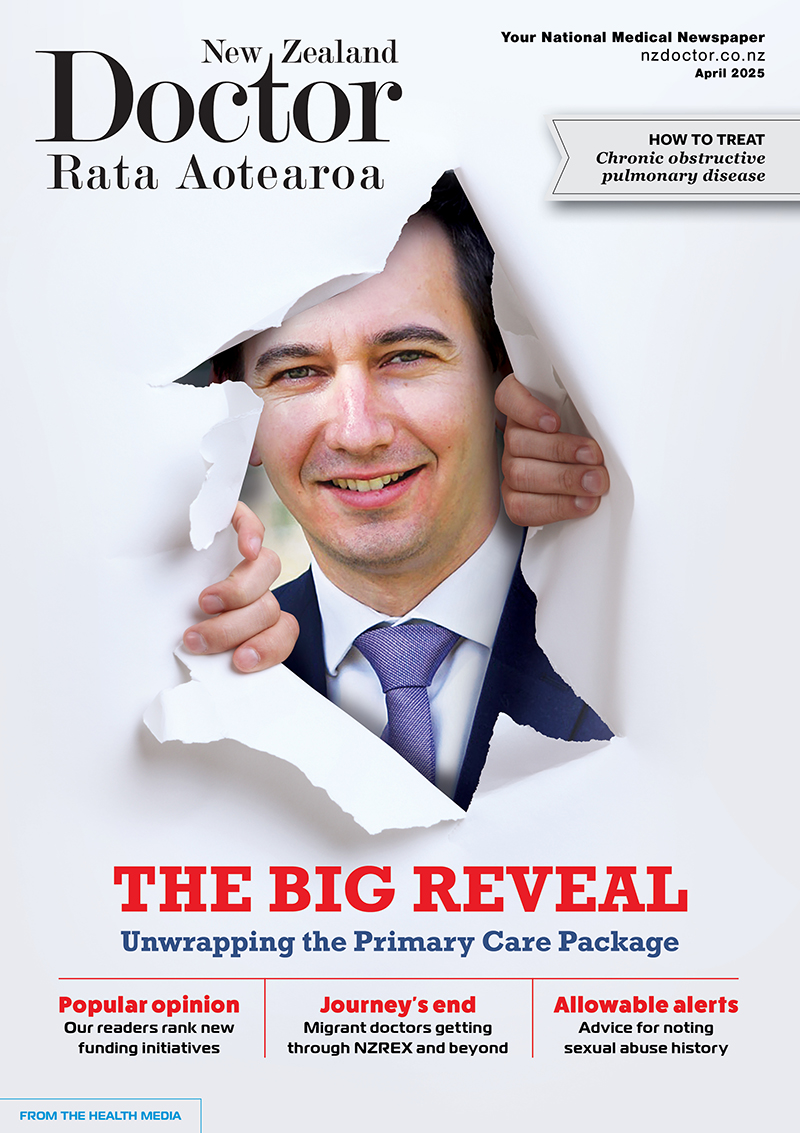Respiratory physician Lutz Beckert considers chronic obstructive pulmonary disease management, including the prevention of COPD, the importance of smoking cessation and pulmonary rehabilitation, and the lifesaving potential of addressing treatable traits. He also discusses the logic of inhaler therapy, moving from single therapy to dual and triple therapy when indicated, as well as other aspects of management
Post-election promises of funding bonanza raise bar for leadership
Post-election promises of funding bonanza raise bar for leadership

Health policy expert Tim Tenbensel, a keen observer of the health sector, sees a tipping point coming for the sector whereby promised new funding could either entrench current ways or open the sector to new possibilities, given some good direction
Well, wasn’t it an intriguing election campaign? All parties in the new Parliament (except ACT, which doesn’t really count) have promised the health sector will receive a significant boost in resources over the next three to four years.
Labour’s figures appear to indicate increases in the order of 12 per cent per year, and National’s around half that. With no indication that either New Zealand First or the Greens will want to resist such increases, the health sector appears set for something of a feast after nearly a decade of very tight purse strings.
This pending influx of resources brings with it some substantial challenges and risks, as this is a “once in 20 years” opportunity to recalibrate our health system.
There are five key things a new government needs to pay attention to, if they are not to waste this opportunity.
First, regardless of whether or not National returns to government, a new minister and new senior leadership at the Ministry of Health are necessary to restore some faith and hope in central government stewardship of the health sector.
It is difficult to remember a period in which sector relationships, particularly those between the Ministry of Health and DHBs, have been so fraught, and this is not only down to nine years of belt-tightening.
In this tough environment, the current minister and director-general have, unfortunately, exacerbated tensions, with the misallocation of DHB budgets earlier this year the most prominent example.
One possible benefit of fresh leadership could be an end to the mixed messages that come from Wellington. For example, is the Canterbury model the best thing since sliced bread or should their claims of transformation be regarded with deep suspicion? Have System Level Measures replaced the regime of health targets as the centrepiece of health sector performance management or not? Hopefully, there are clear answers to these questions by 2018.
A second imperative for a new government is to ensure the extra funding to improve access to primary care is not wasted. Both major parties campaigned on major initiatives to reduce GP copayments for a large proportion of New Zealanders. Although welcome as initiatives to make primary care more affordable, both parties’ proposals run the risk of entrenching further complexity and creating new problems for future governments.
How will any new government address the significant increases in demand and utilisation for primary care services at a time when the primary care workforce is already stretched? How will it prevent the substitution of one barrier of access (cost) with a different barrier (increased waiting times for appointments)?
What will a National-led administration do to ensure individual targeting is effective, given that the last time Community Services Cards were used in the 1990s, over 20 per cent of those eligible did not have a card? And how will a Labour-led government ensure their stop-gap, “see you and raise you $10” primary care funding injection will do anything more than entrench a boost to GP income?
The third imperative is to rejig the funding formulae for DHBs and PHOs, as there is no better time to do so in the political and economic cycle than now. With over 15 years of experience with population-based funding, and improved data capacity, a new government should be able to develop more sophisticated approaches to defining health needs of populations.
This should not be a purely technical exercise but could be an opportunity to foster a constructive debate about the inevitable trade-offs between historical utilisation patterns and future needs.
Any review of funding also needs to counteract the typical forces of gravity in health sector resource allocation. In most health sectors (not just New Zealand), secondary and tertiary hospital services are first in line to absorb increased funding (and the last to be cut), and the primary sector makes do with what’s left. In tough times, funding for PHOs has decreased as a percentage of Vote Health. The same dynamic happens within primary healthcare in which primary medical services are implicitly prioritised, while NGOs delivering non-medical primary healthcare services scrap for the funding crumbs that remain.
A radical approach to funding needs to counteract these forces of gravity – the organisations that make the largest contributions in addressing unmet need and inequities of access to services need to be adequately resourced to maximise their role.
…both parties’ proposals run the risk of entrenching further complexity, and creating new problems for future governments
Fourth, the new government must demonstrate sustained leadership on primary care. Policy drift on this issue dates back to the mid-2000s. Since then, elected governments from both sides have largely failed to consolidate the early gains of the Primary Health Care Strategy.
The Ministry of Health has not been able to monitor progress, identify the models of primary healthcare that are most promising in addressing inequities of access and unmet need, or provide clear advice about preferred future directions.
Little has been done to address the dearth of relevant data required to underpin such advice. Improving policy intelligence will require investment in analytical capacity (either in the ministry itself or through targeted research funding, or both). It will also necessitate serious conversations with primary care sector leaders and PHOs about the sharing of primary care utilisation data.
Finally, whatever new directions in health policy are charted by the next government, we require a public service skilled in anticipating and adapting to changing policy circumstances as they unfold. For far too long, the approach of central government to health policy implementation has been based on the Field of Dreams mantra “if we build it they will come”, largely leaving it to the sector to work through the fine print of implementation, while the ministry stands by powerlessly as the inevitable complexities and fish hooks become apparent and increasingly intractable.
Again, this reflects a failure of elected governments of different colours to invest in and support policy capacity in the ministry. Counteracting this history also requires public officials who have both the space and the courage to speak truth to power.
Tim Tenbensel is associate professor of health policy at the School of Population Health at the University of Auckland
We've published this article as a FREE READ so it can be read and shared more widely. Please think about supporting us and our journalism – subscribe here





![Barbara Fountain, editor of New Zealand Doctor Rata Aotearoa, and Paul Hutchison, GP and senior medical clinician at Tāmaki Health [Image: Simon Maude]](/sites/default/files/styles/thumbnail_cropped_100/public/2025-03/Barbara%20Fountain%2C%20editor%20of%20New%20Zealand%20Doctor%20Rata%20Aotearoa%2C%20and%20Paul%20Hutchison%2C%20GP%20and%20senior%20medical%20clinician%20at%20T%C4%81maki%20Health%20CR%20Simon%20Maude.jpg?itok=-HbQ1EYA)
![Lori Peters, NP and advanced health improvement practitioner at Mahitahi Hauora, and Jasper Nacilla, NP at The Terrace Medical Centre in Wellington [Image: Simon Maude]](/sites/default/files/styles/thumbnail_cropped_100/public/2025-03/2.%20Lori%20Peters%2C%20NP%20and%20advanced%20HIP%20at%20Mahitahi%20Hauora%2C%20and%20Jasper%20Nacilla%2C%20NP%20at%20The%20Terrace%20Medical%20Centre%20in%20Wellington%20CR%20Simon%20Maude.jpg?itok=sUfbsSF1)
![Ministry of Social Development health and disability coordinator Liz Williams, regional health advisors Mary Mojel and Larah Takarangi, and health and disability coordinators Rebecca Staunton and Myint Than Htut [Image: Simon Maude]](/sites/default/files/styles/thumbnail_cropped_100/public/2025-03/3.%20Ministry%20of%20Social%20Development%27s%20Liz%20Williams%2C%20Mary%20Mojel%2C%20Larah%20Takarangi%2C%20Rebecca%20Staunton%20and%20Myint%20Than%20Htut%20CR%20Simon%20Maude.jpg?itok=9ceOujzC)
![Locum GP Helen Fisher, with Te Kuiti Medical Centre NP Bridget Woodney [Image: Simon Maude]](/sites/default/files/styles/thumbnail_cropped_100/public/2025-03/4.%20Locum%20GP%20Helen%20Fisher%2C%20with%20Te%20Kuiti%20Medical%20Centre%20NP%20Bridget%20Woodney%20CR%20Simon%20Maude.jpg?itok=TJeODetm)
![Ruby Faulkner, GPEP2, with David Small, GPEP3 from The Doctors Greenmeadows in Napier [Image: Simon Maude]](/sites/default/files/styles/thumbnail_cropped_100/public/2025-03/5.%20Ruby%20Faulkner%2C%20GPEP2%2C%20with%20David%20Small%2C%20GPEP3%20from%20The%20Doctors%20Greenmeadows%20in%20Napier%20CR%20Simon%20Maude.jpg?itok=B0u4wsIs)
![Rochelle Langton and Libby Thomas, marketing advisors at the Medical Protection Society [Image: Simon Maude]](/sites/default/files/styles/thumbnail_cropped_100/public/2025-03/6.%20Rochelle%20Langton%20and%20Libby%20Thomas%2C%20marketing%20advisors%20at%20the%20Medical%20Protection%20Society%20CR%20Simon%20Maude.jpg?itok=r52_Cf74)
![Specialist GP Lucy Gibberd, medical advisor at MPS, and Zara Bolam, urgent-care specialist at The Nest Health Centre in Inglewood [Image: Simon Maude]](/sites/default/files/styles/thumbnail_cropped_100/public/2025-03/7.%20Specialist%20GP%20Lucy%20Gibberd%2C%20medical%20advisor%20at%20MPS%2C%20and%20Zara%20Bolam%2C%20urgent-care%20specialist%20at%20The%20Nest%20Health%20Centre%20in%20Inglewood%20CR%20Simon%20Maude.jpg?itok=z8eVoBU3)
![Olivia Blackmore and Trudee Sharp, NPs at Gore Health Centre, and Gaylene Hastie, NP at Queenstown Medical Centre [Image: Simon Maude]](/sites/default/files/styles/thumbnail_cropped_100/public/2025-03/8.%20Olivia%20Blackmore%20and%20Trudee%20Sharp%2C%20NPs%20at%20Gore%20Health%20Centre%2C%20and%20Gaylene%20Hastie%2C%20NP%20at%20Queenstown%20Medical%20Centre%20CR%20Simon%20Maude.jpg?itok=Z6u9d0XH)
![Mary Toloa, specialist GP at Porirua and Union Community Health Service in Wellington, Mara Coler, clinical pharmacist at Tū Ora Compass Health, and Bhavna Mistry, specialist GP at Porirua and Union Community Health Service [Image: Simon Maude]](/sites/default/files/styles/thumbnail_cropped_100/public/2025-03/9.%20Mary%20Toloa%2C%20Porirua%20and%20Union%20Community%20Health%20Service%20in%20Wellington%2C%20Mara%20Coler%2C%20T%C5%AB%20Ora%20Compass%20Health%2C%20and%20Bhavna%20Mistry%2C%20PUCHS%20CR%20Simon%20Maude.jpg?itok=kpChr0cc)